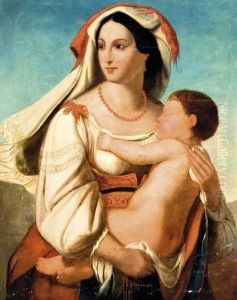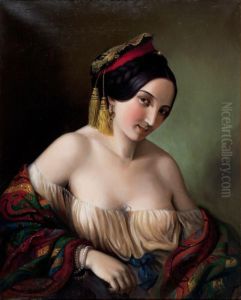Jacopo Marastoni Paintings
Jacopo Marastoni was a 19th-century Italian painter, primarily known for his portraits and historical scenes. Born on July 24, 1804, in Venice, Italy, he developed an interest in art at an early age. Marastoni initially studied at the Academy of Fine Arts in Venice, where he was influenced by the Venetian painting tradition, with its rich color and emphasis on light and atmosphere.
Trained in the neoclassical style, which was prevalent during his early years, Marastoni soon shifted towards a more romantic approach. His work began to reflect the dynamism and emotional expression characteristic of the Romantic movement, which resonated throughout Europe during his lifetime.
Throughout his career, Marastoni was active in different regions of Italy. However, his work also took him beyond the Italian borders, as he sought commissions and opportunities to exhibit his art. He became particularly well known in Hungary, where he contributed significantly to the art scene and is sometimes associated with the Hungarian National Romantic style.
Marastoni's paintings often depicted historical and biblical scenes, as well as portraits of notable figures of his time. His portraits were especially appreciated for their lifelike quality and the skill with which he captured his subjects' personalities. He was adept at using light to enhance the mood of his paintings and to focus the viewer's attention on the most important elements of the composition.
Unfortunately, Jacopo Marastoni's life was cut short when he died on June 15, 1860, in Pest, which is today part of Budapest, Hungary. Despite his premature death, Marastoni left behind a significant body of work that continues to be studied and admired for its technical skill and emotional depth. His contributions to the art of portraiture and history painting are remembered as part of the vibrant 19th-century European art scene.

